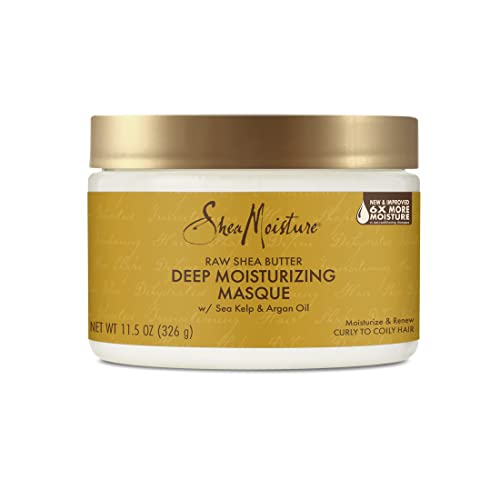
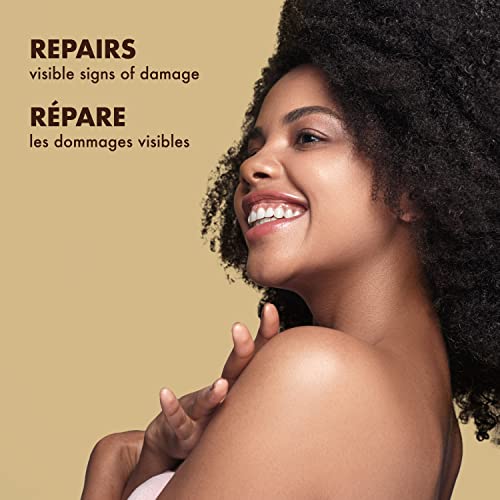
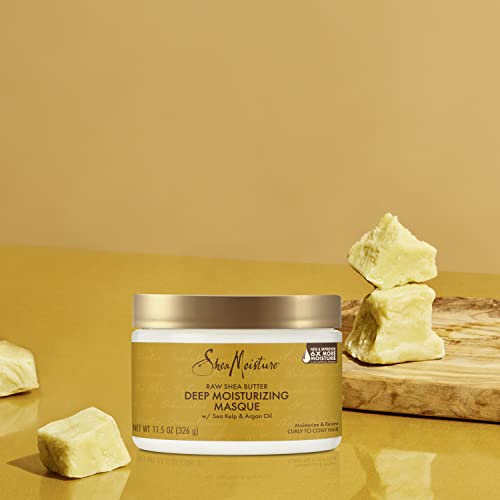
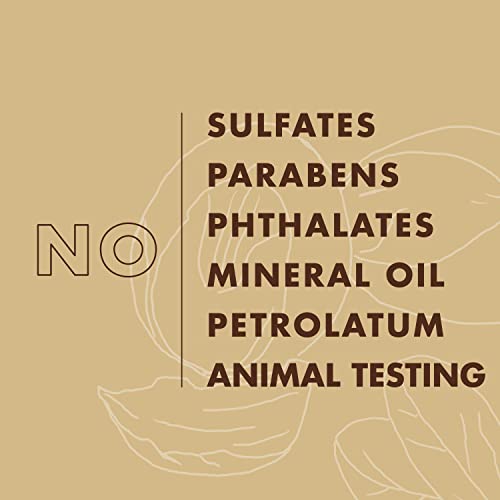
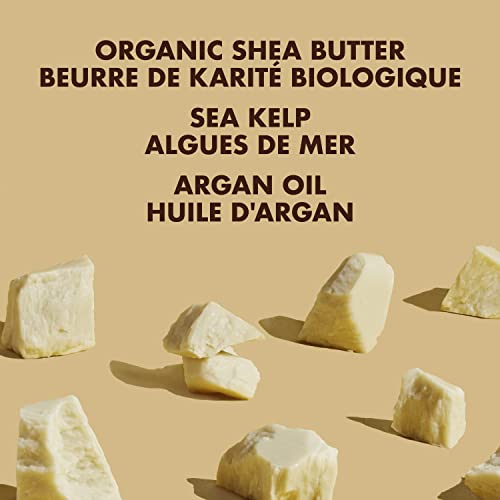
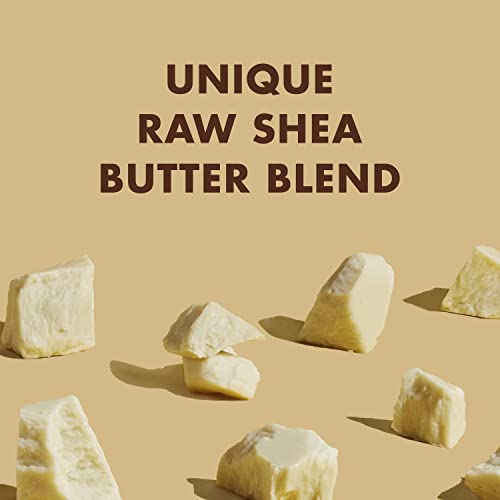
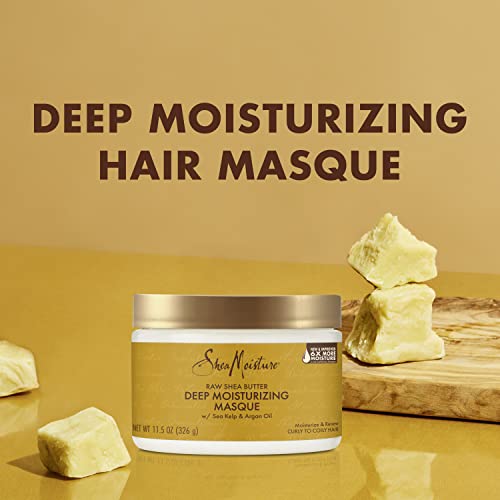
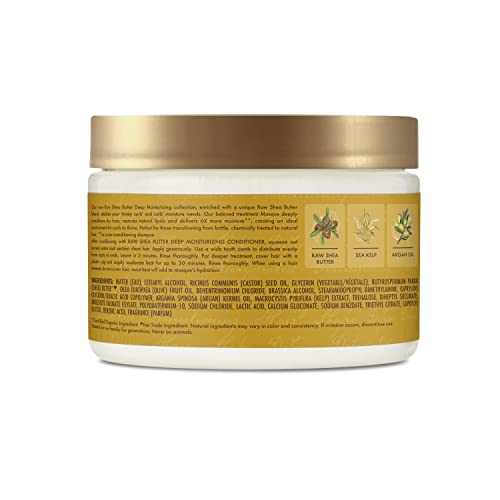



SheaMoisture Hair Mask - Deep Conditioner for Moisture & Renewal, Organic Ingredients - 11.5 fl oz


Lactic Acid, L
High RiskLactic acid is an organic acid commonly used in cosmetics and skincare products as an exfoliant and pH regulator. It helps in improving skin texture and hydration by promoting the shedding of dead skin cells and enhancing moisture retention.
Sustai Insights
Lactic acid offers functional benefits as an effective exfoliant and moisturizer, contributing to improved skin appearance. However, it poses potential risks, including skin irritation and enhanced absorption, which may lead to adverse effects. Regulatory bodies have noted use restrictions due to these concerns. Overall, the ingredient is considered high risk, necessitating cautious usage, particularly for sensitive skin. Alternatives like glycolic acid may provide similar benefits with potentially lower irritation.
Stearamidopropyl Dimethylamine
High RiskStearamidopropyl dimethylamine is a lipid-based compound often used as a conditioning agent in hair care and cosmetic products. It functions primarily as an emulsifier and surfactant, enhancing the texture and manageability of hair by reducing static and improving moisture retention.
Sustai Insights
This ingredient offers functional benefits such as effective conditioning and emulsification in formulations. However, it presents moderate allergenic concerns, while its health risks related to cancer and reproductive toxicity are low. Environmental risks include potential pollutant status, and it is subject to high usage restrictions by regulatory bodies. Overall, it is assessed as high risk, particularly concerning regulatory compliance and potential adverse health effects. Alternatives may include plant-derived emulsifiers or conditioning agents that offer improved safety profiles.
Behentrimonium Chloride
High RiskBehentrimonium chloride is a quaternary ammonium compound primarily used as a conditioning agent in hair and skin care products. It functions as an emulsifier and surfactant, helping to improve texture and manageability of hair.
Sustai Insights
Behentrimonium chloride offers functional benefits as a hair conditioner and emulsifier. However, it is associated with moderate allergenic potential and has high use restrictions due to regulatory concerns. It poses low risks for carcinogenicity and developmental toxicity but has been noted for neurotoxicity. Environmental risks include potential pollution and low biodegradability. Overall, the ingredient is assessed as high risk, and users should consider alternatives such as natural conditioners.
Fragrance
High RiskFragrance refers to a mixture of aromatic compounds used in products to provide scent. It is commonly listed as 'fragrance' or 'parfum' on product labels and can serve various functions, including enhancing user experience and masking undesirable odors.
Sustai Insights
Fragrance offers functional benefits by improving product appeal; however, it poses significant health risks, notably a high likelihood of causing allergies and allergic contact dermatitis. Environmental risks include potential pollution and endocrine disruption, though its overall carcinogenicity is low. Regulatory bodies have noted concerns regarding its use, leading to a high-risk classification. Safe usage practices should be observed, and alternatives such as natural essential oils are recommended for those sensitive to synthetic fragrances.
Ricinus Communis (Castor) Seed Oil
Medium RiskCastor oil is extracted from the seeds of Ricinus communis and is commonly used in cosmetic and personal care products for its moisturizing and emollient properties. It is known for its ability to enhance skin absorption and provide a protective barrier.
Sustai Insights
Castor oil offers functional benefits as a moisturizer and emollient, enhancing skin absorption and providing a barrier against moisture loss. It is sustainably sourced and biodegradable. However, potential health risks include low levels of irritation and moderate concerns regarding developmental and reproductive toxicity. Environmental risks are low, with no significant pollutant or bioaccumulation concerns reported. Regulatory status shows no current restrictions. Overall, the risk level is assessed as medium, with recommendations for safe usage practices, and potential alternatives include other plant-based oils.
Benzoic Acid
Medium RiskBenzoic acid is a naturally occurring and synthetically produced compound commonly used as a preservative in food and cosmetic products. It helps inhibit the growth of mold, yeast, and some bacteria, thus extending shelf life and maintaining product quality.
Sustai Insights
Benzoic acid is effective as a preservative, ensuring product stability and safety. It is generally considered to have low health risks, with minimal concerns regarding carcinogenicity, allergies, or reproductive toxicity. Environmental risks are moderate, as it is not bioaccumulative but can be a pollutant. Regulatory bodies do impose certain restrictions on its use in various products. Safe usage practices should be followed to mitigate any potential risks. Available alternatives include sorbic acid and other natural preservatives, which may offer similar benefits with potentially lower environmental impact. The overall risk level is assessed as medium.
Sodium Benzoate
Medium RiskSodium benzoate is a preservative commonly used in food and cosmetic products to prevent microbial growth and extend shelf life. It is derived from benzoic acid and is effective at low concentrations, often used in acidic environments like beverages and condiments.
Sustai Insights
Sodium benzoate serves effectively as a preservative, contributing to product stability and safety. It is generally recognized as safe with low concerns for carcinogenicity, allergies, and reproductive toxicity, though it faces moderate use restrictions in some regions. Environmental risks include its potential as a pollutant, but it does not bioaccumulate significantly. Regulatory bodies have issued advisories regarding its concentration in products. Overall, the risk level is assessed as medium, with safe usage practices recommended. Alternatives such as potassium sorbate may provide similar benefits with potentially lower restrictions.
Sea Salt
Low RiskSea salt is a mixture of inorganic salts derived primarily from the evaporation of seawater. It consists mainly of sodium chloride, with minor amounts of other minerals. Sea salt is commonly used as a seasoning and preservative in food products and may also have applications in cosmetics and personal care items.
Sustai Insights
Sea salt serves as an effective flavor enhancer and preservative, contributing to the taste and shelf-life of food products. It is generally considered safe with low risk for health concerns such as cancer, allergies, and reproductive toxicity. Environmental impact is minimal, as it does not contribute significantly to pollution or bioaccumulation. Regulatory bodies, including the FDA, currently do not impose restrictions on its use. Overall, the risk level associated with sea salt is low, making it a widely accepted ingredient with no significant adverse effects reported.
Butyrospermum Parkii (Shea) Butter
Low RiskButyrospermum parkii (shea) butter is a vegetable fat derived from the nuts of the shea tree. It is commonly used in cosmetic formulations for its emollient properties, providing moisture and improving skin texture. Additionally, shea butter is known for its ability to enhance the stability of products and deliver a creamy texture.
Sustai Insights
Shea butter offers functional benefits as an effective moisturizer, enhancing skin barrier function and texture. It is sustainably sourced and biodegradable, contributing to eco-friendliness. Health-wise, it is associated with low risks for carcinogenicity, allergies, and reproductive toxicity. Environmental impacts are minimal, with no significant pollutant potential identified. Regulatory assessments indicate no current restrictions. Overall, the ingredient presents a low risk, making it a favorable choice in cosmetic formulations.
Olea Europaea (Olive) Oil
Low RiskOlea europaea (olive) oil is derived from the ripe fruit of the olive tree. It is commonly used in cosmetic formulations primarily as a moisturizer and emollient due to its nourishing properties for the skin. It also serves as a carrier oil for other ingredients in formulations.
Sustai Insights
Olea europaea (olive) oil offers numerous functional benefits, including effective moisturization and enhanced skin absorption properties, making it suitable for various cosmetic applications. It is a biodegradable ingredient, contributing to sustainability when sourced responsibly. Health risks are low, with minimal concerns regarding carcinogenicity, allergenic potential, and developmental toxicity. Environmental risks are also low, with no significant bioaccumulation or pollution potential noted. Regulatory bodies do not impose restrictions on its use. Overall, olive oil presents a low risk profile, making it a favorable choice in cosmetic products.
Calcium Gluconate
Low RiskCalcium gluconate is a calcium salt of gluconic acid, commonly used as a mineral supplement in food and pharmaceuticals. It serves as a source of calcium in dietary formulations and is often included in products to support bone health and metabolic functions.
Sustai Insights
Calcium gluconate is effective for calcium supplementation, contributing to bone health and metabolic processes. It is generally recognized as safe with low risks for carcinogenicity, allergies, or reproductive toxicity. Regulatory statuses indicate no significant concerns, and it is not known to be a pollutant or bioaccumulative. Recommended usage levels are considered safe. Overall, the risk level for calcium gluconate is low, making it a suitable ingredient in various applications.
Brassica Alcohol
Low RiskBrassica alcohol is a fatty alcohol derived from the seeds of Brassica plants, commonly used in cosmetic formulations as an emollient and surfactant. It helps to enhance texture and stability, providing a smooth application in various personal care products.
Sustai Insights
Brassica alcohol offers functional benefits as an emollient and stabilizer, with low associated health risks such as carcinogenicity, allergies, or reproductive toxicity. Environmentally, it poses minimal hazards, being neither a pollutant nor bioaccumulative. Regulatory status indicates no current restrictions. Overall, it is considered low risk, with safe usage practices encouraged. Alternatives may include other fatty alcohols, depending on formulation requirements.
Vegetarian Glycerin
Low RiskVegetarian glycerin, also known as glycerol, is a colorless, odorless, and viscous liquid derived from plant sources. It is primarily used as a humectant, solvent, and emollient in various personal care products, helping to retain moisture and improve texture.
Sustai Insights
Vegetarian glycerin offers functional benefits as an effective humectant, promoting hydration and skin smoothness. It is biodegradable and typically sustainably sourced. Health risks associated with glycerin are low, with no significant concerns for carcinogenicity, allergens, or reproductive toxicity. Environmental risks are minimal, and it is not subject to major regulatory warnings. Overall, the risk level for this ingredient is low, making it a safe choice in formulations. Safe usage practices include ensuring proper concentrations in products, and alternatives such as propylene glycol exist but may have differing properties.
Diheptyl Succinate
Low RiskDiheptyl succinate is an ester derived from heptanoic acid and succinic acid, primarily functioning as a solvent and emollient in cosmetic and personal care products. It is used for its ability to improve the texture and spreadability of formulations.
Sustai Insights
Diheptyl succinate offers functional benefits as an emollient and solvent, enhancing product feel and stability. It is generally regarded as having low health risks, with no significant concerns related to carcinogenicity, allergies, or reproductive toxicity. Environmental risks appear minimal, with no evidence of bioaccumulation or significant pollution potential. Regulatory assessments do not indicate restrictions. Overall, the ingredient is associated with low risk, making it a suitable option in formulations.
Caprylyl Glycol
Low RiskCaprylyl glycol (1,2-octanediol) is a multifunctional cosmetic ingredient primarily used as a skin-conditioning agent and preservative. It is derived from caprylic acid, a fatty acid found in coconut oil, and is commonly included in personal care products for its moisturizing properties.
Sustai Insights
Caprylyl glycol offers functional benefits such as acting as an effective humectant and preservative, enhancing skin hydration and product stability. It is considered to have low health risks, with no significant concerns regarding carcinogenicity, allergies, or reproductive toxicity. Environmentally, it poses minimal risks, being non-bioaccumulative and not linked to pollution. Regulatory assessments affirm its safety, with no major advisories against its use. Overall, the ingredient is assessed to have a low risk, making it a suitable choice in cosmetic formulations.
Polyquaternium 10
Low RiskPolyquaternium-10 is a synthetic polymer used primarily as a conditioning agent in cosmetic products. It enhances the texture and feel of hair and skin, providing moisture retention and improved manageability. This ingredient is known for its film-forming properties, which can help reduce frizz and static.
Sustai Insights
Polyquaternium-10 offers functional benefits in enhancing moisture retention and improving product texture. It is considered to have low health risks, with minimal concerns regarding carcinogenicity, allergenic potential, and neurotoxicity. Environmentally, it poses low ecotoxicity and is not known to bioaccumulate. Regulatory assessments indicate no significant restrictions, categorizing it as low risk overall. For safe use, it is recommended to follow product guidelines. Alternatives include natural conditioning agents like guar gum or xanthan gum for those seeking plant-based options.
Triethylhexyl Citrate
Low RiskTriethylhexyl citrate is a triester of 2-ethylhexanoic acid and glycerin. It functions primarily as a skin-conditioning agent and emollient in cosmetic formulations, enhancing the texture and feel of products while providing moisture retention.
Sustai Insights
Triethylhexyl citrate offers functional benefits as a skin-conditioning agent, promoting moisture retention and product stability. It is considered to have low health risks, including negligible concerns regarding carcinogenicity, allergies, and reproductive toxicity. Environmentally, it poses minimal pollution risk and is not bioaccumulative. Regulatory assessments indicate no significant concerns, affirming its low-risk status overall. Safe usage practices are recommended, and while safer alternatives exist, this ingredient remains a suitable choice in formulations.
Capryloyl Glycerin/Sebacic Acid Copolymer
Low RiskCapryloyl glycerin/sebacic acid copolymer is a copolymer formed from capryloyl glycerin and sebacic acid. It is primarily used in cosmetic formulations for its emollient properties, helping to improve the texture and feel of products on the skin.
Sustai Insights
This ingredient functions effectively as an emollient, enhancing product texture and moisture retention. It is derived from renewable sources and is generally regarded as having low health risks, including low concerns for carcinogenicity, allergies, or reproductive toxicity. Environmental assessments indicate minimal pollutant potential and bioaccumulation. Regulatory reviews show no significant restrictions. Overall, the ingredient presents a low risk profile, with safe usage practices recommended. Alternatives include other plant-derived emollients, which may also provide similar benefits.
Brassicyl Valinate Esylate
Low RiskBrassicyl valinate esylate is a synthetic compound used in cosmetic formulations primarily for its skin-conditioning properties and as a potential anti-aging agent. It is derived from brassicaceae plants and is included in products for its ability to enhance skin texture and appearance.
Sustai Insights
Brassicyl valinate esylate offers functional benefits as a skin conditioning agent, potentially improving the feel and appearance of skin. It is not associated with significant health risks, showing low concerns regarding carcinogenicity, allergenic potential, and reproductive toxicity. Environmentally, it poses low risks with no notable pollutant or bioaccumulation concerns. Regulatory status indicates no current restrictions. Overall, it is assessed to have a low risk level. Safe usage practices should be followed, and while alternatives exist, they may not provide the same functional benefits.
Trehalose
Low RiskTrehalose is a disaccharide composed of two glucose molecules. It occurs naturally in various organisms and is utilized in cosmetic formulations primarily for its moisturizing properties and ability to stabilize proteins and cellular structures.
Sustai Insights
Trehalose offers functional benefits as a humectant and stabilizer, promoting hydration and preserving product integrity. It is considered low risk concerning health impacts, with minimal concerns regarding carcinogenicity, allergies, or reproductive toxicity. Environmentally, it shows low pollutant potential and is biodegradable. Regulatory assessments indicate no significant restrictions. Safe usage practices should be followed, but alternatives are limited. Overall, trehalose presents a low risk profile.
Cetearyl Alcohol
Low RiskCetearyl alcohol is a mixture of cetyl and stearyl alcohol, primarily used as an emulsifier and thickener in cosmetic formulations. It helps stabilize products, improve texture, and enhance moisturizing properties, making it common in creams and lotions.
Sustai Insights
Cetearyl alcohol offers functional benefits as an effective emulsifier and skin-conditioning agent, contributing to product stability and texture. It is generally recognized as safe, with low concerns for carcinogenicity, allergies, or reproductive toxicity. Environmental risks are minimal, as it is biodegradable and has low pollutant potential. Regulatory bodies have not imposed significant restrictions on its use. Overall, cetearyl alcohol is assessed to carry low risk, making it a suitable ingredient choice in cosmetic products.
Water
Low RiskWater is a clear, colorless liquid essential for various biological processes. It serves as a solvent in formulations, facilitating the dissolution of other ingredients and enhancing product texture and application. Additionally, water plays a crucial role in hydration and is a key component in many cosmetic and personal care products.
Sustai Insights
Water is an effective solvent and hydrator, contributing to the texture and efficacy of formulations. It is biodegradable and generally regarded as safe, with low concerns regarding carcinogenicity, allergies, and reproductive toxicity. However, excessive water usage can lead to environmental concerns, particularly regarding resource depletion. Regulatory bodies do not impose restrictions on water use in cosmetics. Overall, the risks associated with water are low, making it a safe and essential ingredient.
Argania Spinosa (Argan) Kernel Oil
Low RiskArgania spinosa (argan) kernel oil is a fixed oil extracted from the kernels of the argan tree, native to Morocco. It is commonly used in cosmetic formulations for its moisturizing properties, serving as an emollient and skin conditioner.
Sustai Insights
Argania spinosa kernel oil offers functional benefits such as effective hydration and nourishment for the skin and hair. It is sustainably sourced and biodegradable, contributing positively to environmental considerations. Health risks are low, with minimal concerns regarding carcinogenicity, allergies, or reproductive toxicity. There are no current regulatory restrictions on its use. Overall, it poses low risk, making it a suitable ingredient in cosmetic products. Safe usage practices should be maintained, and alternatives like jojoba oil may also be considered for similar benefits.
Sea Salt
Low RiskSea salt is a mixture of inorganic salts derived primarily from the evaporation of seawater. It consists mainly of sodium chloride, with minor amounts of other minerals. Sea salt is commonly used as a seasoning and preservative in food products and may also have applications in cosmetics and personal care items.
Sustai Insights
Sea salt serves as an effective flavor enhancer and preservative, contributing to the taste and shelf-life of food products. It is generally considered safe with low risk for health concerns such as cancer, allergies, and reproductive toxicity. Environmental impact is minimal, as it does not contribute significantly to pollution or bioaccumulation. Regulatory bodies, including the FDA, currently do not impose restrictions on its use. Overall, the risk level associated with sea salt is low, making it a widely accepted ingredient with no significant adverse effects reported.
Butyrospermum Parkii (Shea) Butter
Low RiskButyrospermum parkii (shea) butter is a vegetable fat derived from the nuts of the shea tree. It is commonly used in cosmetic formulations for its emollient properties, providing moisture and improving skin texture. Additionally, shea butter is known for its ability to enhance the stability of products and deliver a creamy texture.
Sustai Insights
Shea butter offers functional benefits as an effective moisturizer, enhancing skin barrier function and texture. It is sustainably sourced and biodegradable, contributing to eco-friendliness. Health-wise, it is associated with low risks for carcinogenicity, allergies, and reproductive toxicity. Environmental impacts are minimal, with no significant pollutant potential identified. Regulatory assessments indicate no current restrictions. Overall, the ingredient presents a low risk, making it a favorable choice in cosmetic formulations.
Olea Europaea (Olive) Oil
Low RiskOlea europaea (olive) oil is derived from the ripe fruit of the olive tree. It is commonly used in cosmetic formulations primarily as a moisturizer and emollient due to its nourishing properties for the skin. It also serves as a carrier oil for other ingredients in formulations.
Sustai Insights
Olea europaea (olive) oil offers numerous functional benefits, including effective moisturization and enhanced skin absorption properties, making it suitable for various cosmetic applications. It is a biodegradable ingredient, contributing to sustainability when sourced responsibly. Health risks are low, with minimal concerns regarding carcinogenicity, allergenic potential, and developmental toxicity. Environmental risks are also low, with no significant bioaccumulation or pollution potential noted. Regulatory bodies do not impose restrictions on its use. Overall, olive oil presents a low risk profile, making it a favorable choice in cosmetic products.
Calcium Gluconate
Low RiskCalcium gluconate is a calcium salt of gluconic acid, commonly used as a mineral supplement in food and pharmaceuticals. It serves as a source of calcium in dietary formulations and is often included in products to support bone health and metabolic functions.
Sustai Insights
Calcium gluconate is effective for calcium supplementation, contributing to bone health and metabolic processes. It is generally recognized as safe with low risks for carcinogenicity, allergies, or reproductive toxicity. Regulatory statuses indicate no significant concerns, and it is not known to be a pollutant or bioaccumulative. Recommended usage levels are considered safe. Overall, the risk level for calcium gluconate is low, making it a suitable ingredient in various applications.
Brassica Alcohol
Low RiskBrassica alcohol is a fatty alcohol derived from the seeds of Brassica plants, commonly used in cosmetic formulations as an emollient and surfactant. It helps to enhance texture and stability, providing a smooth application in various personal care products.
Sustai Insights
Brassica alcohol offers functional benefits as an emollient and stabilizer, with low associated health risks such as carcinogenicity, allergies, or reproductive toxicity. Environmentally, it poses minimal hazards, being neither a pollutant nor bioaccumulative. Regulatory status indicates no current restrictions. Overall, it is considered low risk, with safe usage practices encouraged. Alternatives may include other fatty alcohols, depending on formulation requirements.
Ricinus Communis (Castor) Seed Oil
Medium RiskCastor oil is extracted from the seeds of Ricinus communis and is commonly used in cosmetic and personal care products for its moisturizing and emollient properties. It is known for its ability to enhance skin absorption and provide a protective barrier.
Sustai Insights
Castor oil offers functional benefits as a moisturizer and emollient, enhancing skin absorption and providing a barrier against moisture loss. It is sustainably sourced and biodegradable. However, potential health risks include low levels of irritation and moderate concerns regarding developmental and reproductive toxicity. Environmental risks are low, with no significant pollutant or bioaccumulation concerns reported. Regulatory status shows no current restrictions. Overall, the risk level is assessed as medium, with recommendations for safe usage practices, and potential alternatives include other plant-based oils.
Vegetarian Glycerin
Low RiskVegetarian glycerin, also known as glycerol, is a colorless, odorless, and viscous liquid derived from plant sources. It is primarily used as a humectant, solvent, and emollient in various personal care products, helping to retain moisture and improve texture.
Sustai Insights
Vegetarian glycerin offers functional benefits as an effective humectant, promoting hydration and skin smoothness. It is biodegradable and typically sustainably sourced. Health risks associated with glycerin are low, with no significant concerns for carcinogenicity, allergens, or reproductive toxicity. Environmental risks are minimal, and it is not subject to major regulatory warnings. Overall, the risk level for this ingredient is low, making it a safe choice in formulations. Safe usage practices include ensuring proper concentrations in products, and alternatives such as propylene glycol exist but may have differing properties.
Lactic Acid, L
High RiskLactic acid is an organic acid commonly used in cosmetics and skincare products as an exfoliant and pH regulator. It helps in improving skin texture and hydration by promoting the shedding of dead skin cells and enhancing moisture retention.
Sustai Insights
Lactic acid offers functional benefits as an effective exfoliant and moisturizer, contributing to improved skin appearance. However, it poses potential risks, including skin irritation and enhanced absorption, which may lead to adverse effects. Regulatory bodies have noted use restrictions due to these concerns. Overall, the ingredient is considered high risk, necessitating cautious usage, particularly for sensitive skin. Alternatives like glycolic acid may provide similar benefits with potentially lower irritation.
Benzoic Acid
Medium RiskBenzoic acid is a naturally occurring and synthetically produced compound commonly used as a preservative in food and cosmetic products. It helps inhibit the growth of mold, yeast, and some bacteria, thus extending shelf life and maintaining product quality.
Sustai Insights
Benzoic acid is effective as a preservative, ensuring product stability and safety. It is generally considered to have low health risks, with minimal concerns regarding carcinogenicity, allergies, or reproductive toxicity. Environmental risks are moderate, as it is not bioaccumulative but can be a pollutant. Regulatory bodies do impose certain restrictions on its use in various products. Safe usage practices should be followed to mitigate any potential risks. Available alternatives include sorbic acid and other natural preservatives, which may offer similar benefits with potentially lower environmental impact. The overall risk level is assessed as medium.
Diheptyl Succinate
Low RiskDiheptyl succinate is an ester derived from heptanoic acid and succinic acid, primarily functioning as a solvent and emollient in cosmetic and personal care products. It is used for its ability to improve the texture and spreadability of formulations.
Sustai Insights
Diheptyl succinate offers functional benefits as an emollient and solvent, enhancing product feel and stability. It is generally regarded as having low health risks, with no significant concerns related to carcinogenicity, allergies, or reproductive toxicity. Environmental risks appear minimal, with no evidence of bioaccumulation or significant pollution potential. Regulatory assessments do not indicate restrictions. Overall, the ingredient is associated with low risk, making it a suitable option in formulations.
Sodium Benzoate
Medium RiskSodium benzoate is a preservative commonly used in food and cosmetic products to prevent microbial growth and extend shelf life. It is derived from benzoic acid and is effective at low concentrations, often used in acidic environments like beverages and condiments.
Sustai Insights
Sodium benzoate serves effectively as a preservative, contributing to product stability and safety. It is generally recognized as safe with low concerns for carcinogenicity, allergies, and reproductive toxicity, though it faces moderate use restrictions in some regions. Environmental risks include its potential as a pollutant, but it does not bioaccumulate significantly. Regulatory bodies have issued advisories regarding its concentration in products. Overall, the risk level is assessed as medium, with safe usage practices recommended. Alternatives such as potassium sorbate may provide similar benefits with potentially lower restrictions.
Caprylyl Glycol
Low RiskCaprylyl glycol (1,2-octanediol) is a multifunctional cosmetic ingredient primarily used as a skin-conditioning agent and preservative. It is derived from caprylic acid, a fatty acid found in coconut oil, and is commonly included in personal care products for its moisturizing properties.
Sustai Insights
Caprylyl glycol offers functional benefits such as acting as an effective humectant and preservative, enhancing skin hydration and product stability. It is considered to have low health risks, with no significant concerns regarding carcinogenicity, allergies, or reproductive toxicity. Environmentally, it poses minimal risks, being non-bioaccumulative and not linked to pollution. Regulatory assessments affirm its safety, with no major advisories against its use. Overall, the ingredient is assessed to have a low risk, making it a suitable choice in cosmetic formulations.
Polyquaternium 10
Low RiskPolyquaternium-10 is a synthetic polymer used primarily as a conditioning agent in cosmetic products. It enhances the texture and feel of hair and skin, providing moisture retention and improved manageability. This ingredient is known for its film-forming properties, which can help reduce frizz and static.
Sustai Insights
Polyquaternium-10 offers functional benefits in enhancing moisture retention and improving product texture. It is considered to have low health risks, with minimal concerns regarding carcinogenicity, allergenic potential, and neurotoxicity. Environmentally, it poses low ecotoxicity and is not known to bioaccumulate. Regulatory assessments indicate no significant restrictions, categorizing it as low risk overall. For safe use, it is recommended to follow product guidelines. Alternatives include natural conditioning agents like guar gum or xanthan gum for those seeking plant-based options.
Triethylhexyl Citrate
Low RiskTriethylhexyl citrate is a triester of 2-ethylhexanoic acid and glycerin. It functions primarily as a skin-conditioning agent and emollient in cosmetic formulations, enhancing the texture and feel of products while providing moisture retention.
Sustai Insights
Triethylhexyl citrate offers functional benefits as a skin-conditioning agent, promoting moisture retention and product stability. It is considered to have low health risks, including negligible concerns regarding carcinogenicity, allergies, and reproductive toxicity. Environmentally, it poses minimal pollution risk and is not bioaccumulative. Regulatory assessments indicate no significant concerns, affirming its low-risk status overall. Safe usage practices are recommended, and while safer alternatives exist, this ingredient remains a suitable choice in formulations.
Capryloyl Glycerin/Sebacic Acid Copolymer
Low RiskCapryloyl glycerin/sebacic acid copolymer is a copolymer formed from capryloyl glycerin and sebacic acid. It is primarily used in cosmetic formulations for its emollient properties, helping to improve the texture and feel of products on the skin.
Sustai Insights
This ingredient functions effectively as an emollient, enhancing product texture and moisture retention. It is derived from renewable sources and is generally regarded as having low health risks, including low concerns for carcinogenicity, allergies, or reproductive toxicity. Environmental assessments indicate minimal pollutant potential and bioaccumulation. Regulatory reviews show no significant restrictions. Overall, the ingredient presents a low risk profile, with safe usage practices recommended. Alternatives include other plant-derived emollients, which may also provide similar benefits.
Brassicyl Valinate Esylate
Low RiskBrassicyl valinate esylate is a synthetic compound used in cosmetic formulations primarily for its skin-conditioning properties and as a potential anti-aging agent. It is derived from brassicaceae plants and is included in products for its ability to enhance skin texture and appearance.
Sustai Insights
Brassicyl valinate esylate offers functional benefits as a skin conditioning agent, potentially improving the feel and appearance of skin. It is not associated with significant health risks, showing low concerns regarding carcinogenicity, allergenic potential, and reproductive toxicity. Environmentally, it poses low risks with no notable pollutant or bioaccumulation concerns. Regulatory status indicates no current restrictions. Overall, it is assessed to have a low risk level. Safe usage practices should be followed, and while alternatives exist, they may not provide the same functional benefits.
Stearamidopropyl Dimethylamine
High RiskStearamidopropyl dimethylamine is a lipid-based compound often used as a conditioning agent in hair care and cosmetic products. It functions primarily as an emulsifier and surfactant, enhancing the texture and manageability of hair by reducing static and improving moisture retention.
Sustai Insights
This ingredient offers functional benefits such as effective conditioning and emulsification in formulations. However, it presents moderate allergenic concerns, while its health risks related to cancer and reproductive toxicity are low. Environmental risks include potential pollutant status, and it is subject to high usage restrictions by regulatory bodies. Overall, it is assessed as high risk, particularly concerning regulatory compliance and potential adverse health effects. Alternatives may include plant-derived emulsifiers or conditioning agents that offer improved safety profiles.
Behentrimonium Chloride
High RiskBehentrimonium chloride is a quaternary ammonium compound primarily used as a conditioning agent in hair and skin care products. It functions as an emulsifier and surfactant, helping to improve texture and manageability of hair.
Sustai Insights
Behentrimonium chloride offers functional benefits as a hair conditioner and emulsifier. However, it is associated with moderate allergenic potential and has high use restrictions due to regulatory concerns. It poses low risks for carcinogenicity and developmental toxicity but has been noted for neurotoxicity. Environmental risks include potential pollution and low biodegradability. Overall, the ingredient is assessed as high risk, and users should consider alternatives such as natural conditioners.
Fragrance
High RiskFragrance refers to a mixture of aromatic compounds used in products to provide scent. It is commonly listed as 'fragrance' or 'parfum' on product labels and can serve various functions, including enhancing user experience and masking undesirable odors.
Sustai Insights
Fragrance offers functional benefits by improving product appeal; however, it poses significant health risks, notably a high likelihood of causing allergies and allergic contact dermatitis. Environmental risks include potential pollution and endocrine disruption, though its overall carcinogenicity is low. Regulatory bodies have noted concerns regarding its use, leading to a high-risk classification. Safe usage practices should be observed, and alternatives such as natural essential oils are recommended for those sensitive to synthetic fragrances.
Trehalose
Low RiskTrehalose is a disaccharide composed of two glucose molecules. It occurs naturally in various organisms and is utilized in cosmetic formulations primarily for its moisturizing properties and ability to stabilize proteins and cellular structures.
Sustai Insights
Trehalose offers functional benefits as a humectant and stabilizer, promoting hydration and preserving product integrity. It is considered low risk concerning health impacts, with minimal concerns regarding carcinogenicity, allergies, or reproductive toxicity. Environmentally, it shows low pollutant potential and is biodegradable. Regulatory assessments indicate no significant restrictions. Safe usage practices should be followed, but alternatives are limited. Overall, trehalose presents a low risk profile.
Cetearyl Alcohol
Low RiskCetearyl alcohol is a mixture of cetyl and stearyl alcohol, primarily used as an emulsifier and thickener in cosmetic formulations. It helps stabilize products, improve texture, and enhance moisturizing properties, making it common in creams and lotions.
Sustai Insights
Cetearyl alcohol offers functional benefits as an effective emulsifier and skin-conditioning agent, contributing to product stability and texture. It is generally recognized as safe, with low concerns for carcinogenicity, allergies, or reproductive toxicity. Environmental risks are minimal, as it is biodegradable and has low pollutant potential. Regulatory bodies have not imposed significant restrictions on its use. Overall, cetearyl alcohol is assessed to carry low risk, making it a suitable ingredient choice in cosmetic products.
Water
Low RiskWater is a clear, colorless liquid essential for various biological processes. It serves as a solvent in formulations, facilitating the dissolution of other ingredients and enhancing product texture and application. Additionally, water plays a crucial role in hydration and is a key component in many cosmetic and personal care products.
Sustai Insights
Water is an effective solvent and hydrator, contributing to the texture and efficacy of formulations. It is biodegradable and generally regarded as safe, with low concerns regarding carcinogenicity, allergies, and reproductive toxicity. However, excessive water usage can lead to environmental concerns, particularly regarding resource depletion. Regulatory bodies do not impose restrictions on water use in cosmetics. Overall, the risks associated with water are low, making it a safe and essential ingredient.
Argania Spinosa (Argan) Kernel Oil
Low RiskArgania spinosa (argan) kernel oil is a fixed oil extracted from the kernels of the argan tree, native to Morocco. It is commonly used in cosmetic formulations for its moisturizing properties, serving as an emollient and skin conditioner.
Sustai Insights
Argania spinosa kernel oil offers functional benefits such as effective hydration and nourishment for the skin and hair. It is sustainably sourced and biodegradable, contributing positively to environmental considerations. Health risks are low, with minimal concerns regarding carcinogenicity, allergies, or reproductive toxicity. There are no current regulatory restrictions on its use. Overall, it poses low risk, making it a suitable ingredient in cosmetic products. Safe usage practices should be maintained, and alternatives like jojoba oil may also be considered for similar benefits.
Discover the transformative power of SheaMoisture Raw Shea Butter Deep Moisturizing Hair Masque. This luxurious hair treatment is designed to deeply moisturize and revitalize dry, damaged hair, making it a must-have for anyone seeking healthy, vibrant locks.
- Intense Moisture & Conditioning: Enriched with Raw Shea Butter, Sea Kelp, and Argan Oil, this mask delivers a potent blend of nutrients that hydrate and nourish your hair from root to tip.
- Perfect for All Hair Types: Ideal for transitioning chemically treated hair or enhancing the natural beauty of your curls, this masque suits a variety of hair needs.
- Sustainably Sourced Ingredients: Crafted with care, this product is cruelty-free and free from silicones, sulfates, parabens, and phthalates, ensuring a gentle touch on your hair and the planet.
- User-Friendly Application: Easy to use, simply apply to clean, damp hair, leave for 10-30 minutes, and rinse for soft, manageable hair.
- Community Impact: SheaMoisture supports ethical sourcing and community trade, fostering positive change while providing exceptional hair care.
Elevate your hair care routine with this deep conditioner and enjoy the health benefits of natural ingredients.
Subscribe & Save with Sustai
- Best Price Guarantee: Always enjoy the lowest prices on sustainable home essentials.
- No Surprises: We’ll notify you before shipping. No hidden fees, ever.
- You’re in Charge: Change, pause, or cancel your subscription anytime with ease.
- Eco-Friendly Deliveries: Our grouped shipments mean less packaging and lower emissions.
Join us on a sustainable journey. Special offers for a limited time! Prices and promotions may change.
Recommended Products
Discover the transformative power of SheaMoisture Raw Shea Butter Deep Moisturizing Hair Masque. This luxurious hair treatment is designed to deeply moisturize and revitalize dry, damaged hair, making it a must-have for anyone seeking healthy, vibrant locks.
- Intense Moisture & Conditioning: Enriched with Raw Shea Butter, Sea Kelp, and Argan Oil, this mask delivers a potent blend of nutrients that hydrate and nourish your hair from root to tip.
- Perfect for All Hair Types: Ideal for transitioning chemically treated hair or enhancing the natural beauty of your curls, this masque suits a variety of hair needs.
- Sustainably Sourced Ingredients: Crafted with care, this product is cruelty-free and free from silicones, sulfates, parabens, and phthalates, ensuring a gentle touch on your hair and the planet.
- User-Friendly Application: Easy to use, simply apply to clean, damp hair, leave for 10-30 minutes, and rinse for soft, manageable hair.
- Community Impact: SheaMoisture supports ethical sourcing and community trade, fostering positive change while providing exceptional hair care.
Elevate your hair care routine with this deep conditioner and enjoy the health benefits of natural ingredients.

You can have at most 2 Sustainable Steals products in your cart
Customer Reviews
Customers’ View
Customers appreciate the SheaMoisture Raw Shea Butter Deep Moisturizing Hair Masque for its effective hydration and natural ingredients. Many users note that it leaves their hair feeling soft, shiny, and manageable, with a pleasant scent that enhances the overall experience. The product is particularly praised for its ability to rejuvenate wavy and curly hair, helping to define curls while minimizing frizz. However, some reviews highlight mixed feelings regarding its thickness and potential stickiness, with a few customers mentioning that it can feel heavy or difficult to apply. Environmentally conscious consumers will value its eco-friendly formulation, free from harsh chemicals, making it a safer choice for both hair health and the environment. Overall, this hair mask aligns well with the needs of health-conscious users seeking effective, natural hair care solutions.
AI-generated from the text of customer reviewsThis product is rated 4.9 of 5.0 stars.
It has received 18 reviews.




